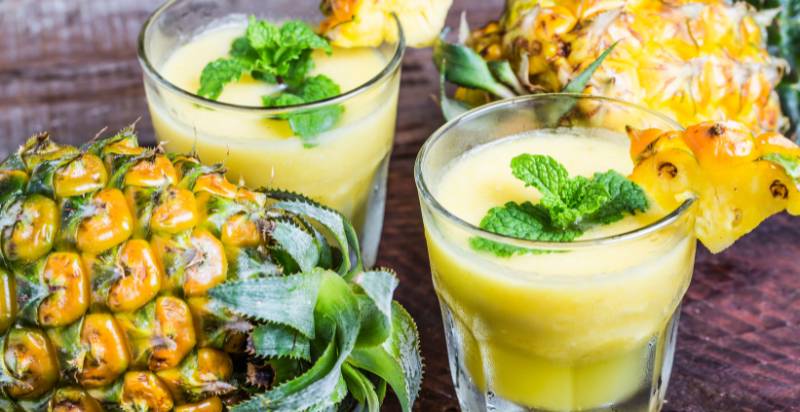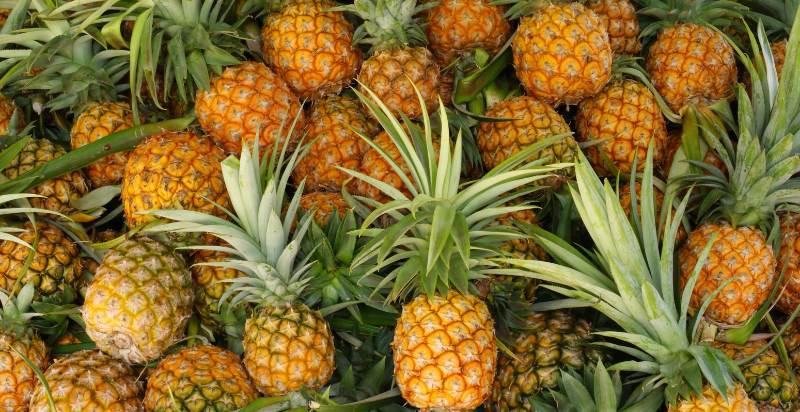Did you know that the pineapple plant, Ananas comosus, is a herb? It is not closely related to apples, as its name might suggest, but is more closely related to gourds. The pineapple plant originated in the West Indies and is a native of South America.
Pineapples were brought to Europe by Christopher Columbus in 1493, and they quickly became a popular fruit. However, in the 18th century, pineapples began to grow commercially. Its production rose rapidly in the 19th century due to increasing demand from European and American consumers.
Today, tropical and subtropical regions, such as Hawaii, Brazil, the Philippines, and Thailand, are where pineapples are farmed. This guide will teach you how to cultivate and take care of your pineapple plant by reading this article.
What is Pineapple?
The pineapple (Ananas comosus) is a tropical plant with an edible fruit called an anonymouscomosus, or simply ananás. It is the most economically significant member of the family, Bromeliaceae.
Description of Pineapple Plant:
Pineapples are perennial plants with short stems and tough, waxy leaves. The leaves of a pineapple plant are arranged in a spiral pattern around the central stem. The pineapple fruit is a compound (multiple) that develops from the flowers that grow on the plant’s stalk.
This plants can be grown outdoors in tropical and subtropical climates or indoors as houseplants. Pineapples require full sun and well-drained soil to thrive. Once established, pineapples are relatively drought tolerant.
Pineapples are typically propagated by rooting the top of the fruit, which includes several inches of stem attached to a few leaves. The rooted tops can then be planted in soil to grow new pineapple plants.
Cultivation of Pineapple Plant:
Pineapples are native to South America and were first cultivated in the region that is now Panama. Pineapples were later introduced to Europe by Christopher Columbus and subsequently spread to other parts of the world by European colonists and traders.
Uses of Pineapple Plant:
The fruit of the pineapple is eaten fresh or canned. Pineapple juice is also popular. This plant leaves can be used to make fiber for textile production.
Pineapples contain a proteolytic enzyme called bromelain, which has several culinary and industrial uses. Bromelain is used as a meat tenderizer and in producing beer and wine.
Pineapples are also used as ornamental plants, owing to their attractive appearance.

Nutritional Benefit of the Pineapple Plant:
Vitamin C is abundant in pineapples, along with manganese and fiber. They also contain several other vitamins and minerals. Despite having few calories, pineapples are packed with nutrients. This makes them an excellent food to include in a healthy diet.
Pineapples are a good source of antioxidants. These substances help protect the body from damage caused by toxins and free radicals. Antioxidants have been associated with a lower risk of developing chronic diseases, including cancer and heart disease.
Pineapples are also a good source of enzymes that can help with digestion. One enzyme, in particular, bromelain, has been shown to have anti-inflammatory effects. An inflammation process occurs in the body in reaction to damage or illness. It is distinguished by discomfort, swelling, and redness.
Bromelain treats some conditions involving inflammation, such as arthritis and menstrual cramps. Pineapples are also a good source of fiber. Fiber is beneficial for the digestive system and can aid with constipation.
Pineapples are a nutritious fruit that can be enjoyed as part of a healthy diet. Including pineapples in your diet may offer some health benefits, such as aiding digestion, reducing inflammation, and boosting immunity.
Health Benefits of Pineapple Plant:
Pineapples may offer some health benefits due to their nutrient content and antioxidant activity. Pineapple bromelain has been shown to reduce inflammation and swelling, and its juice has traditionally been used as a folk remedy for coughs and sore throats.
Pineapples may also boost immunity due to their vitamin C content. The efficient operation of the immune system depends on the water-soluble vitamin C, an antioxidant in the body.
How to Grow and Care for your Pineapple Plant?
Pineapples are one of the most popular tropical fruits and one of the easiest to grow! All you need is fresh pineapple, some potting soil, and a little bit of patience.
Growing your pineapple plant is a fun and interesting project for kids and adults, and it’s a great way to start gardening. But before starting the gardening, here are a few things you need to know about growing Pineapple plants such as :
Climate
Pineapple plants need warm weather to thrive. They can be grown outdoors in tropical and subtropical climates. If you live in a low temperate climate, you can grow this plant indoors near a sunny window.
Soil
Pineapple plants prefer sandy, well-drained soil. Mix in sand or peat moss to improve drainage if your soil is heavy or clay-like. The pH of the soil should be between 5.5 and 6.5.
Fertilizer
Pineapple plants need a high-nitrogen fertilizer to produce healthy leaves and fruit. Apply fertilizer every two weeks during the growing season. Use a half-strength solution of liquid fertilizer, or follow the directions on the package.
Watering
Pineapple plants need regular watering, but the soil should be kept from becoming waterlogged. Water your plant deeply, then allow the soil to dry before watering again. During the fruiting season, increase watering to keep the soil moist but not soggy.

Pruning
It do not require pruning, but you can trim dead or dying leaves. You can also remove the lower leaves to allow more air circulation and prevent disease.
Harvesting
Pineapple plants take about 18 months to mature. The fruit is ready to harvest when it is fully ripe. To test for ripeness, pull on the fruit gently. If it comes off easily, it is ready to eat. Use a sharp knife to cut the fruit from the plant, being careful not to cut the stem.
Now that you know the basics about growing a pineapple plant. Here’s what you’ll need to get started:
- A fresh pineapple
- Potting soil
- A pot or container
- A sunny spot
To start, cut the top off of your pineapple about 1-2 inches from the fruit. You’ll want to ensure that a few leaves are still attached to the top.
Next, gently remove any excess fruit from the base of the pineapple top. This will help to prevent rot.
Now, it’s time to plant! Fill your pot or container with potting soil, and make a small hole in the center. Gently insert the pineapple top into the hole, and firm the soil around it.
Water your pineapple plant well, and place it in a sunny spot. Keep the soil moist but not soggy. In a few weeks, you should see new growth emerge from the pineapple top’s center.
Once your plant is established, you can begin fertilizing it every few months with a balanced fertilizer. Make sure to adhere to the fertilizer’s label directions.
Pineapples generally take about 18-24 months to produce fruit, but the wait is worth it! Once your plant blooms, the pineapple will ripen in about 3-4 months. You’ll know it’s ready to harvest when the fruit turns golden.
To harvest, cut the pineapple from the plant. Enjoy your homegrown pineapple fresh, or use it in your favorite recipes.
With a little bit of care, your pineapple plant will produce fruit for many years to come. Enjoy!

How To Store Fresh-Grown Pineapple:
Pineapples are tropical fruit found fresh year-round in many places. Here are a few different ways to do it.
One way is to cut the pineapple into slices or chunks and store it in an airtight container in the refrigerator. This will keep the pineapple fresh for up to a week.
Pineapple can also be preserved by being left whole and uncut. It will remain fresh for up to two weeks if stored in a cold, dry environment. If you require longer-term storage, remove the pineapple’s top, wrap it in plastic, and place it in the freezer. It can remain edible for up to six months.
When ready to use your pineapple, thaw it out and enjoy. No matter how you store it, fresh pineapple is a delicious and healthy treat everyone can enjoy.
Troubleshooting:
Pineapple plants are generally trouble-free, but there are a few problems that you may encounter.
- Brown leaves are usually caused by too much fertilizer or insufficient water. Cut back on fertilizer and increase watering.
- Yellow leaves are usually caused by too much water or poor drainage. Allow the soil to dry out between waterings, and improve drainage by mixing in sand or peat moss. If the problem persists, check the pH of the soil and adjust as necessary.
- Fruit drop: This can be caused by too much or too little water, stress, or pests. Make sure you are watering regularly and evenly. Try to avoid stress factors such as temperature fluctuations and excessive wind. Check for pests such as aphids, spider mites, and scale insects.
Pineapple plants are beautiful and easy to grow, making them a delicious addition to any garden. With a little care, your plant will produce healthy fruit for many years.
Possible Risks:
Pineapples are generally safe to eat, but there are a few potential risks to be aware of. Bromelain, the proteolytic enzyme found in pineapples, can act as a blood thinner. Therefore, people taking blood thinners or other medications should avoid consuming large amounts of pineapple.
The hard, fibrous core of the pineapple contains high levels of bromelain, so it should be avoided if you are taking blood thinners or other medications. Bromelain can also cause diarrhea, so it is best to avoid pineapple if you have a sensitive stomach.
Pineapples may also trigger allergic reactions in some people. Allergic reactions to pineapple can range from mild (such as skin irritation) to severe (anaphylaxis). People with latex or Birch pollen may be more likely to have a pineapple allergy.
If you experience any adverse effects after eating pineapple, you should discontinue use and consult your healthcare provider.
There are numerous ways to consume pineapples, which are nutritious and delicious fruit. The majority of the time, eating pineapples is risk-free, but there are a few things to be careful of. Take advantage of this tropical fruit’s various health advantages by eating fresh pineapple as part of a balanced diet.
Conclusion:
Pineapples are a delicious, healthy fruit that can be enjoyed fresh or in various recipes. They are easy to grow at home and make a beautiful addition to any garden. With a little care, your pineapple plant will produce fruit for many years.
Possible risks associated with pineapples include the possibility of allergic reactions and adverse effects if consumed in large quantities. However, these risks are typically only relevant to a small population. For most people, pineapples are a healthy, delicious treat that can be enjoyed without worry.
- Water Berries: Description, Flavor, Benefits, And Uses - June 18, 2024
- Everything You Wanted To Know About Sweetheart Cherries - June 17, 2024
- Indian Jujube: Description, Flavor, Benefits, And Uses - April 30, 2024

30 thoughts on “How to Grow and Care for Your Pineapple Plant”
Comments are closed.